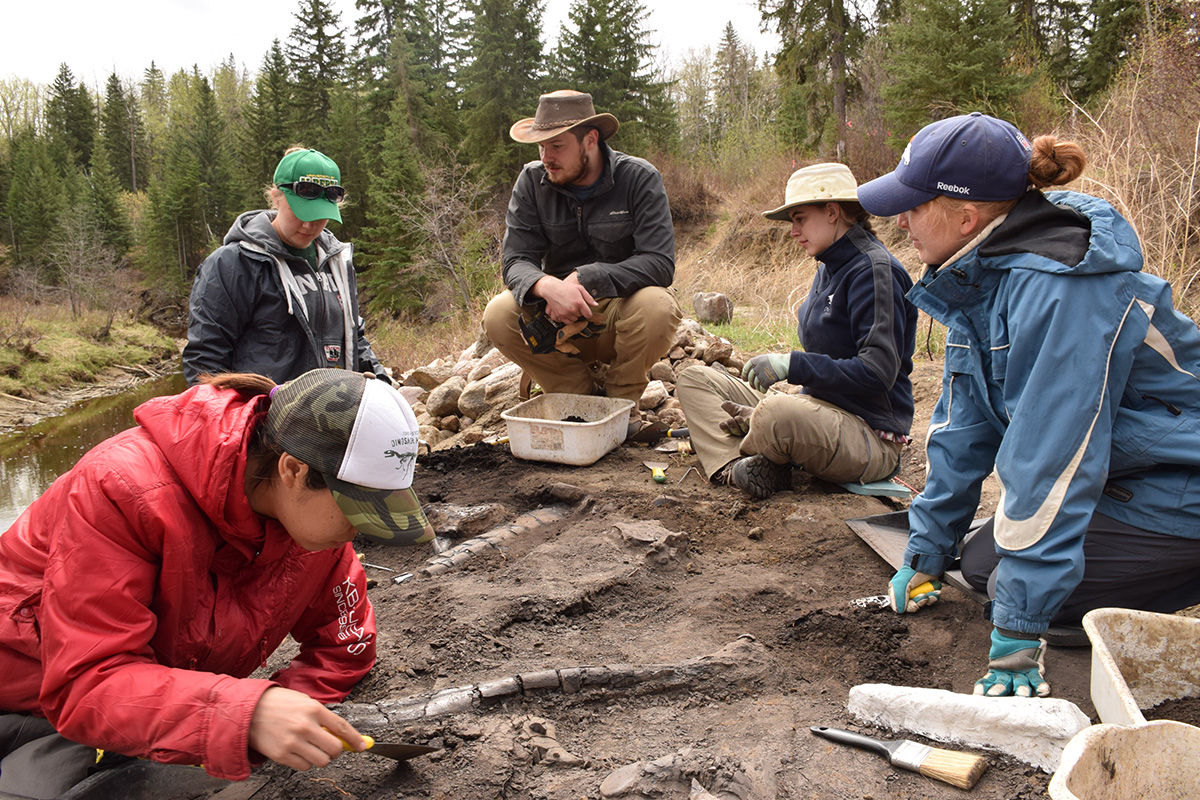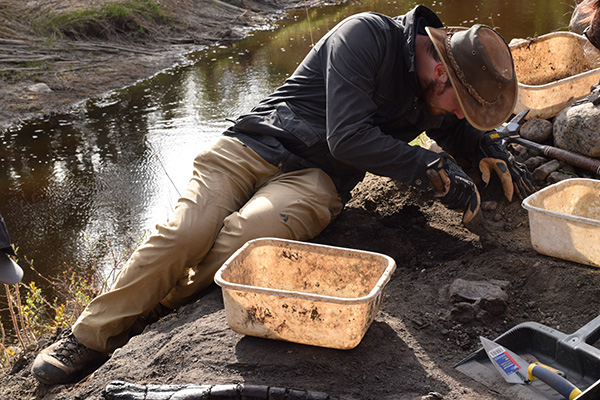
The Danek bonebed, first discovered in 1989 by amateur fossil enthusiast Danek Mozdzenski, is not only Edmonton's very own backyard dino dig site, but since 2008 it has also been the location of the University of Alberta's Paleontology Field School: Paleo 400. Credit: Michaela Ream
"I heard you aren't a real paleontologist until you break a fossil."
The comment comes from one of four paleontology field school students sitting gathered around a set of exposed dinosaur fossils with their chisels and dental picks in hand at the ready. The fossils date back to the late Cretaceous period, which ended 66 million years ago, making these fossils very old and very fragile. The field school students size up the fossils, looks are exchanged, tools lowered…and careful precision excavation of the fossils begins. It was a typical paleontologist's joke, nothing more.
Ask anyone who has either taken field school before or is currently undergoing one, and they will probably tell you all about the benefits of the experience. After all, you get to apply and experience your craft in the field, as opposed to hearing about it within a classroom.
The problem for paleontology students, however, is that there isn't usually an abundance of available dinosaur dig sites or convenient backyard access to a fossil rich location to host a field school at….unless you are a student at the University of Alberta that is.
The Danek bonebed, first discovered in 1989 by amateur fossil enthusiast Danek Mozdzenski, is not only Edmonton's very own backyard dino dig site, but since 2008 it has also been the location of the University of Alberta's Paleontology Field School: Paleo 400.

From the classroom to the field
Each year, six to eight students from the university attend the PALEO 400 field school for the chance to apply some of that hard-learned classroom knowledge to actual hands-on experience and learn the excavation techniques of a paleontologist. Such techniques range from digging-lots of digging-collecting, curating, and eventually analyzing the fossils.
Furthermore, the field school is not limited to just students interested in pursuing a career in paleontology, an aspect which Philip Currie, renowned paleontologist and field school mentor, points out. "It gives the opportunity to try something without having to commit a career."
This opportunity also includes some of those "behind the scenes" experiences that people don't think about. Specifically, Currie explains, realizing that you don't just go out and find a fossil right away-unfortunately it's not that easy. Rocks have to be cleared, dirt carefully dug away, and even the conditions play a factor: rain, snow, strong winds or hot days. No matter the weather, an excavation must continue-especially if there is an exposed fossil which may be damaged by the elements. Of course, these conditions all apply as well to the field school students, who spend three weeks at the dig site regardless of the weather; it's a full package experience of field work.
Nevertheless, the students that attend each year delve into the experience with the same enthusiasm, and this year's students are no different-including those with high hopes of becoming paleontologists themselves.
"I don't remember a time I didn't. Growing up, that's what I was being," says Dana Whitcomb, one of this year's six field students, adding "I never grew out of the dinosaur phase."
Alongside Currie, Eva Koppelhus, renowned paleobotanist and palynologist, also teaches the field school students, and together they have guided ten years of students through field school, but also guided them in advice for their futures.
"I have been teaching on and off all my life," says Koppelhus. "I always tell the students that they should never give up."
Currie likewise gives his students similar advice. "Be passionate about what they want to do and go for it," he says, adding, "Be realistic on the one hand, but if you have a dream on the other: go for it."
Both of their advice comes from firsthand experience, though Currie in particular notes that despite wanting to become a paleontologist since he was six, he never though his dream would actually come true. Luckily though, both Currie and Koppelhus pursued their dreams and ended up achieving their goals and more and can now set their sites on encouraging their students to do the same.
Of this year's six field school students, only two are pursuing a career in paleontology, and only one has attended a paleontology field school before. Yet as they all sit or crouch around exposed fossils to carefully brush away dust or meticulously clear layers of dirt away, the scene appears no different than that of professional paleontologists hard at work.
Mysteries of the past
Any intact fossil or skeleton is a cause of excitement for a paleontologist, but finding a site riddled with the bones of many, many dinosaurs is a cause for celebration to any paleontologist-with due respect to the deceased dinosaurs, of course.
A bonebed, as its name may suggest, is a site that has become the resting place to a large number of fossils and bones of dinosaurs usually having died due to different circumstances and over time. What may look like a jumbled site of scattered bones to anyone else, is in fact a buried storybook to the eyes of a paleontologist, just waiting to be revealed.
When Mozdzenski first discovered the sight, when he saw a portion of a dinosaur skeleton sticking out of the bank of the river bed, it was thought he had just found one skeleton. However, further excavations of the site by Alberta's Royal Tyrrell Museum resulted in 80 more specimens being brought to the museum. Now, since 2006, the site has revealed more than 1000 bones and 15 full skeletons. Of these skeletons and bones, the most common has been the Edmontosaurus (a large duck-billed dinosaur) and the teeth of Albertosaurus (a smaller sized tyrannosaurus).
However, the Danek bonebed is of particular interest because it is the site of what paleontologists refer to as a mass death wherein the dinosaurs appeared to have died all at the same time rather than naturally and over time.
Of the Edmontosaurus' that have been found, there have been 15 individuals that range from babies to full adults, and aside from the discovery of teeth from Albertosaurus', which suggest that the carcasses were fed on after death, there is as of yet no clear explanation for what caused the mass death of the Edmontosaurus'.
Whatever the answer to the mysteries of their death may be, one thing that does remain clear is that each year the field school students have the chance to take part in unveiling the past and moving closer to uncovering the answer.